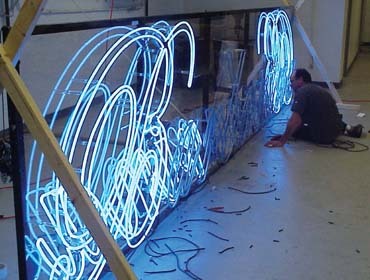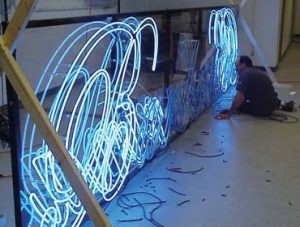Light and light(n)ing effects have always brightened the entertainment industry. Increasingly, neon is being used on stage and movie sets, as well as for TV shows. Based on personal experience, I can vouch that these applications’ requirements deviate from normal neon applications. This month, I’ll take you backstage for insights that could open the curtain for some neon shops to play a role in this challenging field. But beware, only the good guys (and gals, of course) will survive to the happy ending. Words to the wise In the early 20th Century, the introduction of electric light and its easy controllability revolutionized onstage lighting technology. Since then, neon, as a colorful, custom light source, has gained greater prominence for scenic setups. For any neon shop, the stage manager’s requirements will present challenges. Here are a few:
• Absolute adherence to timeframes. Either the neon will be ready on time, or, to borrow an old Hollywood saying, "You’ll never work in this town again."
• Unfailing reliability. If the neon fails or flickers during the grand-opening show, your shop will experience a guaranteed blackout, even if nobody in the audience notices.
• No audio interference. Sound technicians don’t like anything that interferes with their audio systems. You’ll be surprised how sensitive their ears are — even the gentle hum of a magnetic transformer usually eliminates them from consideration for theatrical uses.
• Team organization. Determine who’s responsible for which task before beginning installation. Your team must match the stage-crew hierarchy, which resembles a colony of ants or bees. Stage crews are usually unionized, and their structures are often different from signshops.
Fade to black
Advertisement
In most cases, stage and studio sets require dimmability. If the production managers allow magnetic transformers, underload them to avoid flickering tubes at low dimmer settings and high-voltage spikes (the "buzz"), especially when red tubes are used in the circuit. Always use low-power-factor, magnetic transformers with dimmers.
In most cases, theater dimmers can withstand a neon transformer’s inductive load. But, allow enough time for a test setup. If the neon’s intensity is unstable at low settings, you might need to add some resistive load, such as a powerful lightbulb in parallel to the primary of the transformer. This will stabilize the dimmer’s timing and eliminate flickering.
For electronic power supplies, direct digital control via DMX-512 protocol is today’s standard. A few neon power supplies can be directly connected to this dimming system (see ST, June 2005, page 20). Complete, PC-based stage-control systems are prime examples. For larger installations, discuss channel grouping and load splitting with the responsible lighting or stage electrician.
Hold your fire
All studio and stage people are afraid of fire, for good reason. In European studios and theaters, the electrical wires must bear a 356° F (180° C) continuous rating. Because standard GTO is normally only rated for 221° F (105° C), use silicone GTO and pure-silicone electrode boots and caps for high-voltage wiring.
Stage managers usually dictate that technical equipment be invisible, which generally requires remote transformer locations and bundled, lengthy GTO runs. To avoid flickering and buzzing (and keep the sound producers happy), I normally split circuits and employ smaller, multiple transformers — 6,000V or smaller — 9,000V and 15,000V models are simply out of the question.
Advertisement
Plan ahead
Some stage installations must travel, which requires careful planning to protect the tube layout and mechanical structure. Design the tubes’ layout for easy repair in case they break. But, it’s best to produce well supported, rigid tubes that won’t break.
Keep tubes short — avoid long arms that extend from angles or double backs (double backs are the weakest part). Also, don’t skimp on tube supports — spring-loaded supports can absorb some shock. Finally, allow ample wiring flexibility (note that GG cups aren’t appropriate for tube interconnections here).
Even the best plan can’t anticipate all trapdoors — a test setup proves Murphy’s Law. In some cases, it’s worthwhile to encase straight units in plastic tubing for more rigidity. But, make sure the plastic material is rated for electrode temperatures, which may exceed 225° F.
Most stage managers know about neon’s possibilities and push the envelope further by asking for special effects, such as a seemingly defective sign, crackle neon or plasma effects. This is atypical work for a standard signshop, so you may need specialists familiar with the secrets of successful special effects (see list of providers).
However, here’s one commonly requested, neon special effect. Technicians often capitalize on neon’s quick on-and-off possibilities, rather high intensity and arbitrary shapes that imitate lightning. Normally, I use 8mm, ice-blue/white between 8,500 and 14,000K, which I run on a 60 or 100mA transformer. Because lightning only strikes a moment, the overload on tiny electrodes doesn’t matter.
Advertisement
But, make sure your white fluorescent coating doesn’t cause an afterglow, which natural lighting doesn’t produce. Test different whites beforehand by flashing them in your shop.
Don’t expect too much growth in money or reputation from stage jobs. However, they could become an interesting sideline to spice up your shop. Just remember that most stage technicians appreciate new ideas, but not new providers. They tend to stay with established partners who’ve proven themselves over the long haul. Only a few shops serve this market, and they’ll continue because they know what they’re doing. It’s a hard job — take it from someone who worked as a "studiohead" in his life before neon and physics.
Neon Special-Effects Providers
Krypton Neon
Long Island City, NY
(718) 728-4450
www.neonshop.com
Lightwriters Neon Inc.
Northbrook, IL
(847) 291-4160
www.lightwriters.com
Plasma Graphics
Atlantic City, NJ
(609) 344-6366
Strattman Design
Boston
(617) 266-8821
www.strattman.com



 Photo Gallery2 weeks ago
Photo Gallery2 weeks ago
 Ask Signs of the Times2 weeks ago
Ask Signs of the Times2 weeks ago
 Paula Fargo1 week ago
Paula Fargo1 week ago
 Real Deal6 days ago
Real Deal6 days ago
 Photo Gallery1 week ago
Photo Gallery1 week ago
 Women in Signs2 weeks ago
Women in Signs2 weeks ago
 Projects6 days ago
Projects6 days ago
 Women in Signs2 weeks ago
Women in Signs2 weeks ago











